My thoughts on the General Election
What happened in Suffolk, what happened to the Tories more generally, and how we move forward from here...
I am delighted to have fulfilled an ambition of mine to become a Member of Parliament. Even more delighted to do so representing my home, Suffolk. There is a huge amount of criticism in how the Conservative Party selects candidates to stand in seats at the General Election (more on this in the future, but it is worth saying, the Labour Party is far less opaque and un-meritocratic), and my experience of the process was characteristically chaotic. But I am proud to be a local candidate, who won a tough election by staying positive and focussing on what we plan to deliver for the people of Central Suffolk and North Ipswich.
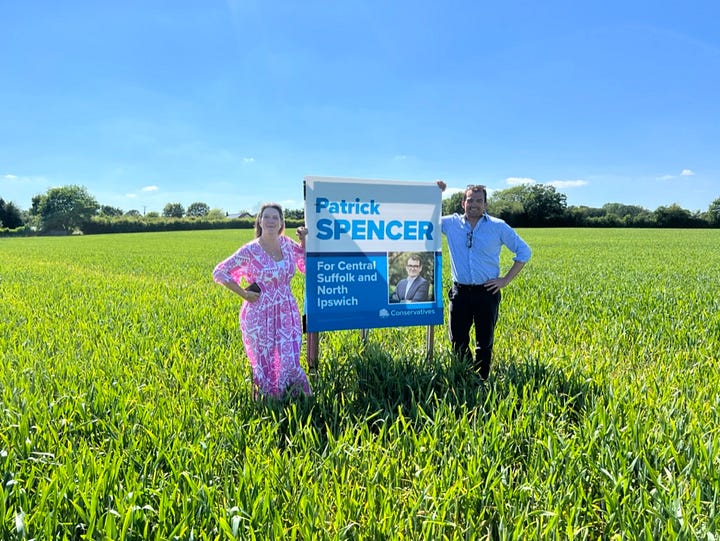



We won with a majority of 4,290. A massive reduction from the 23,391 majority in 2019, albeit a large majority by the standards of Conservatives in 2024. It would be disingenuous not to mention the fact my Labour opposition candidate was suspended half way through the campaign, having being caught up in the betting scandal. But I profoundly believe that Central Suffolk and North Ipswich is not natural Labour territory, nor is it hunting ground for Reform. And our positive campaign won support from people who wanted to see a fresh local voice representing them in Parliament. However the story behind my much reduced majority, and the wider Tory wipeout, is one that you can see replicated across the country, and one I want to delve into here - Conservative voters not turning out.
A few take-aways…
The national figures that darted across our screens that night read awfully. 6.8m people voted Conservative in 2024, down from nearly 14 million in 2019. We went from winning 43.5% of the vote and 365 seats to 23.7% and just 121 seats. By any measure, it was a disaster. These are MY PERSONAL take-aways…
It was not about policies… it was about personality and competence - There are a plethora of theories as to why the Conservative Party got hammered so badly at this General Election. However, the main ‘reason’ I believe people didn’t vote blue was a failure to project any competence in Government. It was not a problem of policy, instead it was one of personality. When I knocked on doors in Suffolk people were angry about the failure to deliver on key pledges (cost of living, immigration and the NHS). They were angry with a party that had been involved in so many scandals, from Party-gate, to the Truss-budget disaster, and of course, the gambling scandal. There was also a considerable amount of antipathy for our Leader, especially after the D-Day fiasco. This all congealed into a sense that the traditional party of Government was no-longer fit to run and rule.
As former Party Leader Sir Iain Duncan Smith said recently in a Telegraph article: “Finally, a key reason for why people once trusted the Conservative Party – our ability to govern competently – was destroyed by our own behaviour. Whilst Party-gate initiated this slump in public opinion, it went wider. By the time Rishi Sunak – the third Tory prime minister in as many years – stood in the rain in Downing Street to announce the election, Conservatives were seen as self-serving, dishonest and incompetent.”
What I believe this means for the future, is that new policy initiatives will have little impact on our immediate electoral success. I do not believe people voted for Reform because the Conservative Party was either too left wing or right wing. Nor did they vote Labour because the country had shifted their opinion on the size of the state or our stance of Europe and immigration. It was about faith in the Conservatives to govern effectively. It was lost, and voters wanted to give the party a good kicking to remind them. Standing on a traditional platform of ‘low taxes, economic growth, standing tall on the international stage, and public sector reform’ remains important in the long term, but in the near term we need to focus on detoxifying our image and returning the party to a place of public faith, trust and respect.
Reform split the local Tory vote, giving Labour the victory in 139 seats and Lib Dems victory in 27 seats - Reform UK’s predecessor, The Brexit Party was an irrelevance at the 2019 General Election, winning just 644,000 votes. This clearly changed in 2024, with Reform UK, led by Nigel Farage, winning 4.1 million votes (remarkably 600,000 more than the Liberal Democrats).
Where did those votes come from and how much of it was direct Con-Reform switchers? The estimate varies according to the source. Lord Ashcroft Polls estimate one quarter of the 2019 vote - 3.2 million people - who had backed Boris Johnson, went on to vote for Reform in 2024. Lord Ashcroft also estimate Labour benefited from a surge in tactical voting; 1.2 million 2019 Liberal Democrat voters and 250,000 2019 Green Voters shifted allegiance to Labour this year. YouGov estimate the Con-Reform Shift to be slightly smaller at 2.7 million, either way. It was a large figure which effectively split the traditional conservative vote allowing Labour to come through the middle.
The impact on seats was huge. Labour took 182 seats from the Conservatives at the General Election. In 139 of those seats, Reform won more votes than the Labour majority (Reform’s votes were more than double the Labour majority in 73 of those seats). The Liberal Democrats took 60 seats from Conservatives, in 27 of which Reform had more votes than the Lib Dem majority.
Look at Derbyshire Dales. Tory MP Sarah Dines lost 12,000 votes, with almost 8,000 of those going to Reform. Labour picked up approximately 6,000 new votes, and now sit on a slim majority of 350. Or in South East Cornwall, where Sheryl Murray lost half her voter base, with a large portion going to Reform. The same story in Redditch where Rachel Maclean lost 14,000 votes (half the 28,000 she won in 2019) with a large chunk of those going to Reform, some going to Labour, and a lot staying at home.
Tory voters didn’t turn up, and this cost us dear - Whereas the first two points I make above are, frankly, blindingly obvious, this one is more subtle. Yes a lot of voters left us for Reform, but when they do that in Houghton and Sunderland South (16.09% swing from Con to Ref), or Makerfield (21.07% swing from Con to Ref), the relevance to the overall long term Tory strategy is negligible, because we were never going to win either of those seats. What was more concerning was overall turnout.
Conservatives who won (like we did in Central Suffolk and North Ipswich) did so in seats where turnout was above average (e.g. above the national turnout of 60%). Of the 328 seats where turnout was below 60% (for instance in Redditch or Liz Truss’s seat in South West Norfolk) the Conservatives won 17 seats (5%). Of the 322 seats where turnout was above 60%, they won 104 (approximately one-third of them). That is to say, when turnout went above average, the probability of Conservatives returning as MPs increased by a factor of 6. At the extremes, where turnout was higher than 70% or below 50% the data is even more stark.
The broader problem of voter apathy, demographic challenges and turnout is visualised in this piece of analysis by YouGov which shows approximately 1.7 million 2019 Conservative voters staying at home in 2024 while another 1.4 million did not vote because they had sadly passed away. Overall YouGov estimate that 3.1 million 2019 Tory voters didn’t vote at all (more than the 2.7 million who moved to Reform, and the 1.1 million who left us to vote for Labour).
It was Tory voters who did not turnout that cost us a lot of seats. Yes Reform had a devastating impact, but a general apathy towards politics and the Conservative Party, and a lack of fear of Kier Starmer (unlike Jeremy Corbyn who motivated as much opposition as he did devotion on his own side) meant the Tory base stayed at home and we struggled to retain seats that would normally fall our way. It was in many ways, a perfect political storm for us.
How does the Conservative Party win in 2029?
Where do we go from here…
The very first point to make is that I believe we can win in 5 years time. There are a lot of Labour MPs sitting on thin majorities. 26 MPs on a majority of less than 1,000, 49 on a majority of less than 2,000, and 111 MPs on a majority of less than 5,000. These do include some seats that have been historically Labour, that they might expect to keep in a post-Boris/Brexit world – Peterborough, Stoke on Trent South, and Middlesbrough South and East Cleveland. But it also includes seats like Poole that has been Conservative since the 19th Century, Derbyshire Dales which hasn’t elected a Labour MP since the end of the war, and South West Norfolk which has a similar Tory dominant history. A small 5% swing towards the Conservative Party, on the back of a refreshed and energised party with cohesiveness behind a popular leader, would see us win approximately 100 seats (seats like Welwyn Hatfield, Banbury and Harlow) back off Labour. An 8% swing (a lot of this coming from higher turnout) and we are in the realm of being able to form a Government.
Lurching to the right in an effort to wedge Farage and Reform on issues of immigration and culture strikes me as misguided. Firstly, the Tory Party has thrust immigration down the throats of the British electorate now for 3 years with its slogan to ‘Stop the Boats’. At the end of the day, prioritising immigration is one thing, delivering on a promise to cut net migration and illegal immigration is another. We categorically failed to the latter, and the British public were fed up. Secondly, Nigel Farage has a unique relationship with the British public that has been built up over 10+ years and centres on his own authenticity. This cant be undone overnight with strong words on immigration and culture wars. It can only be done by building back a relationship with the British public that is rooted in the same principle of authenticity and honesty.
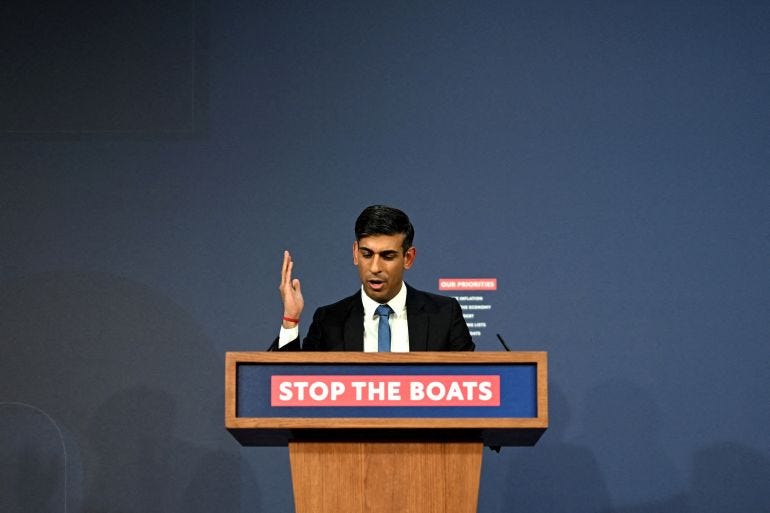
Finally, our voters are out there and they are not voting for Labour. In 1997 Tony Blair won with 43% of the vote. Kier won with 33% this year, a marginally larger share of the vote than Jeremy Corbyn but on a much reduced turnout. That they returned such a huge parliamentary majority is deceiving. As many people have said, their majority is broad but shallow. If the Conservatives can motivate those that stayed at home (the modern day ‘shy tory’) they can begin to redevelop their political franchise. If they can also tempt the hesitant switchers back from Labour and Reform (those who cited personality and competence as their reason to switch), the party is back in government forming territory. How we do this is another matter (and for another blog), but a starting point can be found in The Times today, where they referenced Labour strategists pointing to voters aged between 40-59 as a key component of their victory. They “are more likely to have backed Brexit, earn between £20,000 and £55,000, and have a mortgage and young family”… but who feel squeezed, victims of the Truss fiasco. Build an aspiring conservative story around this group, and it is easy to see the party back in contention very quickly.
Conclusion
The next few years will be tough for the Conservative Party. Labour has an indomitable position in parliament, able to pass legislation with the support of barely three-quarters of its parliamentary party. The rogue elements of McDonnell and Zultana will not worry Government Whips. Having said that, their superior position in the House of Commons with almost two-thirds of all seats, does not reflect a political mandate across Britain. Two-thirds of voters didn’t vote for Kier Starmer. 85% of the British public didn’t back him. Soon this Government will face a more hostile public unhappy if things dont improve as quickly as they are making out they will under their leadership.




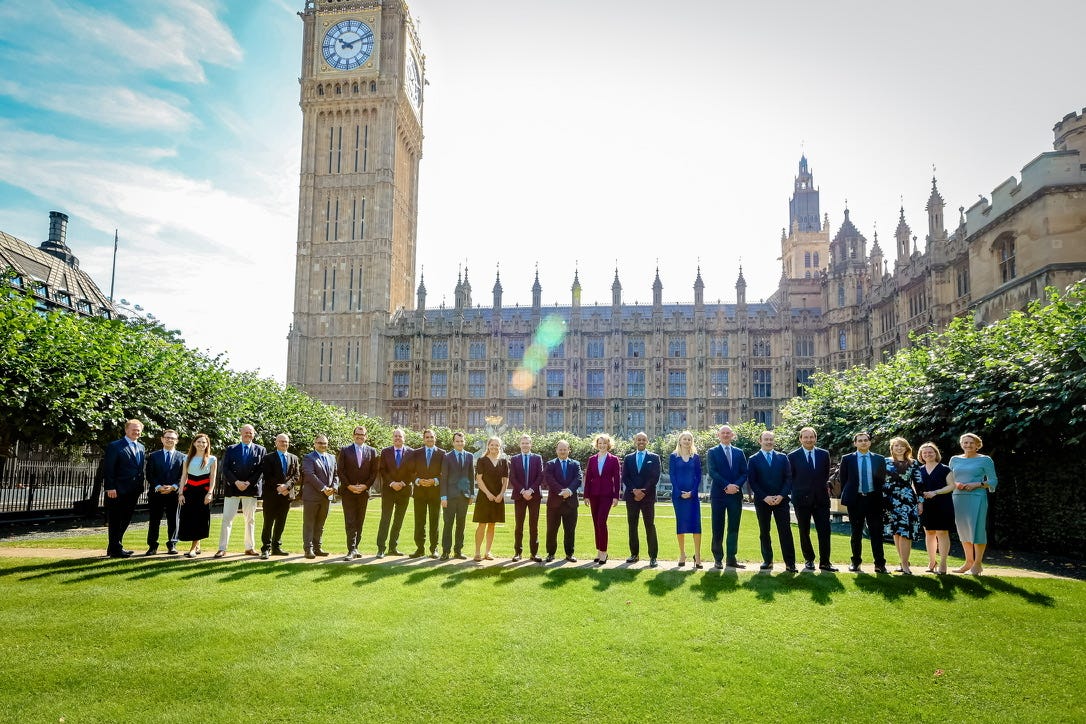

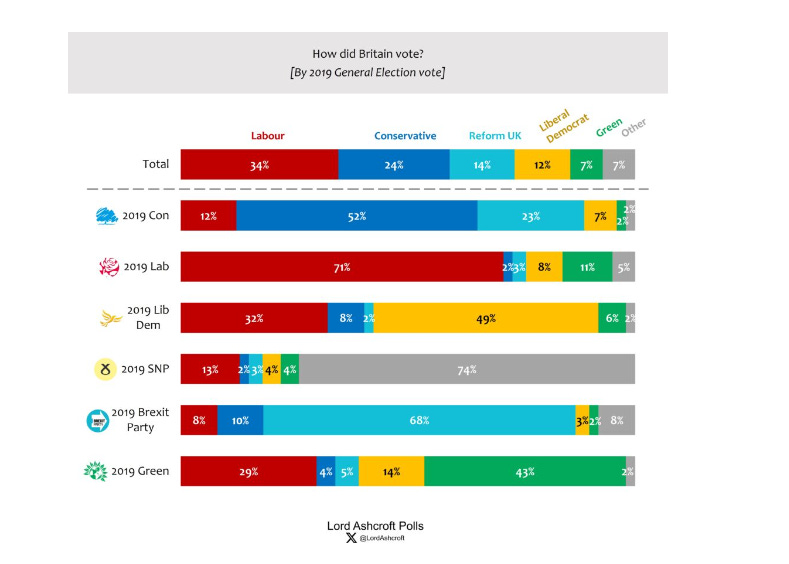

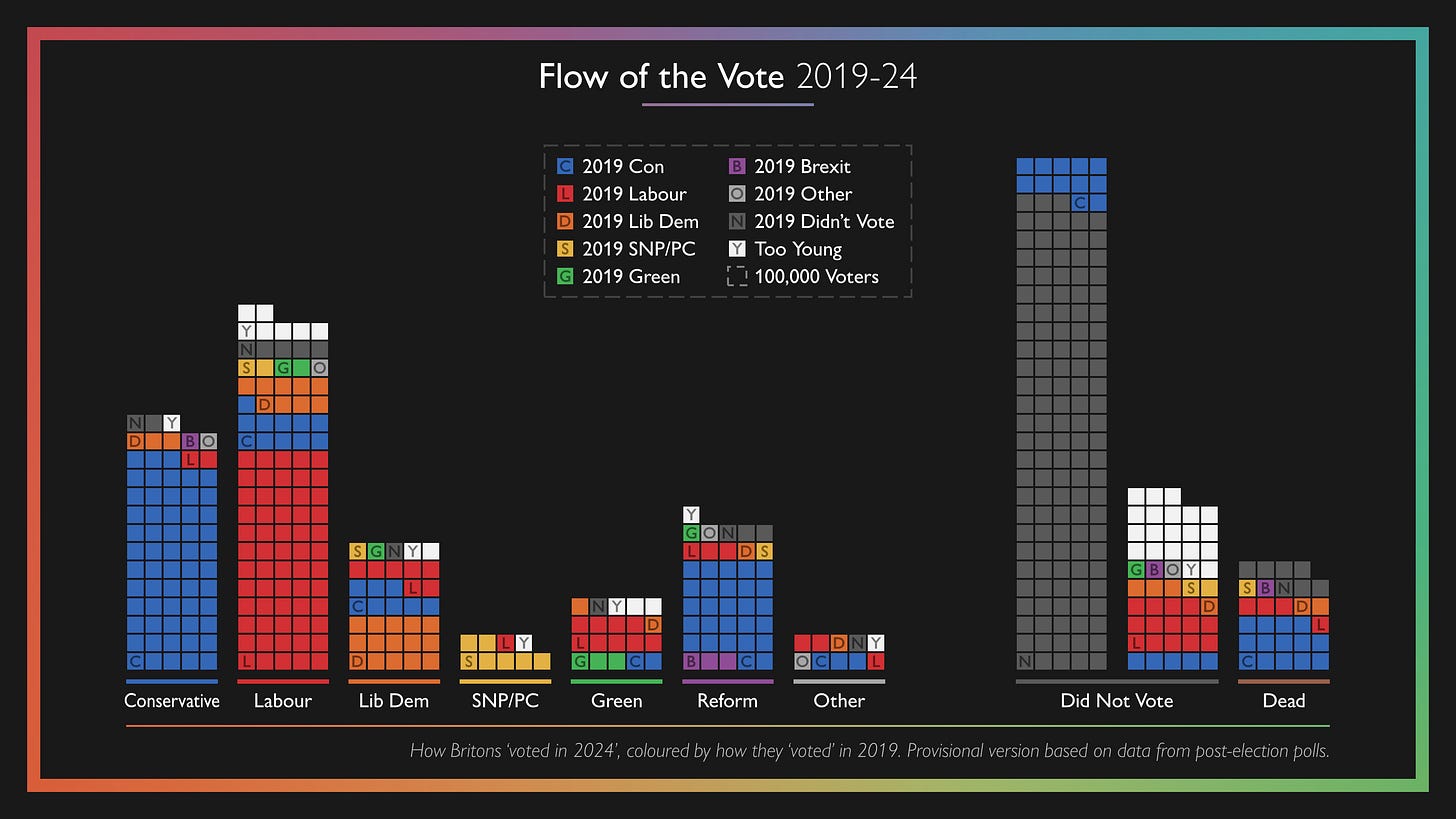

Great piece.